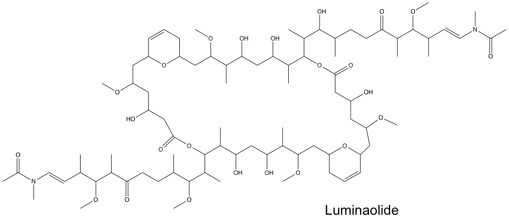Contents
 Swinholide A | |
| Identifiers | |
|---|---|
| |
3D model (JSmol) | |
| ChEMBL |
|
| ChemSpider | |
PubChem CID | |
| |
| |
| Properties | |
| C78H132O20 | |
Except where otherwise noted, data are given for materials in their standard state (at 25 °C [77 °F], 100 kPa). | |
Swinholides are dimeric 42 carbon-ring polyketides that exhibit a 2-fold axis of symmetry. Found mostly in the marine sponge Theonella, swinholides encompass cytotoxic and antifungal activities via disruption of the actin skeleton. [1] Swinholides were first described in 1985 [2] and the structure and stereochemistry were updated in 1989 [3] and 1990, [4] respectively. Thirteen swinholides have been described in the literature, including close structural compounds such as misakinolides/bistheonellides, [5] ankaraholides, [6] and hurgholide A [7] It is suspected that symbiotic microbes that inhabit the sponges rather than the sponges themselves produce swinholides since the highest concentration of swinholides are found in the unicellular bacterial fraction of sponges and not in the sponge fraction or cyanobacteria fraction that also inhabit the sponges. [4] [8] [9]
From a marine field sample containing the cyanobacterium Symploca sp, Swinholide A has also been reported in literature. [6] The structural analogs of swinholides, ankaraholides, were also found from the cyanobacterium Geitlerinema sp. in the same experimental study. [6] Since sponges host a range of bacteria, including symbiotic cyanobacteria, it is often wondered how swinholides are produced. [1] A study of the production of misakinolide revealed that it was attributed to the Theonella symbiont bacterium Candidatus Entotheonella via the discovery of a trans-AT polyketides synthase (PKS) biosynthesis gene cluster. [1] This demonstrates that the true origin of swinholides is symbiotic bacteria that inhabit sponges. [1]




